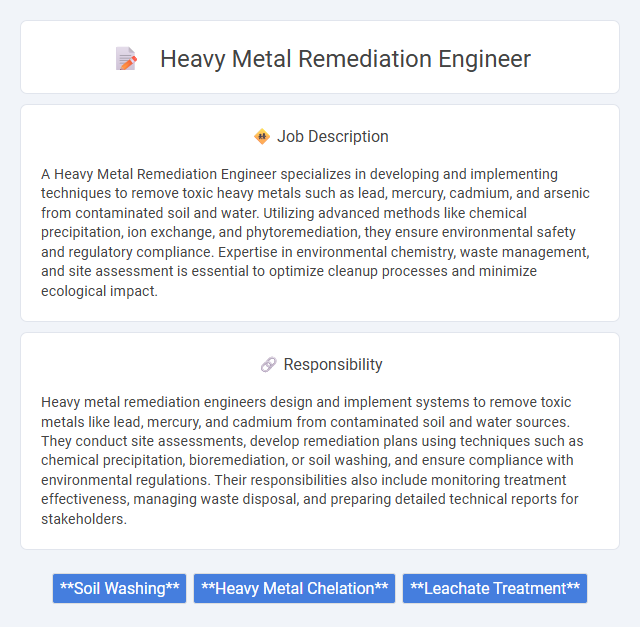
A Heavy Metal Remediation Engineer specializes in developing and implementing techniques to remove toxic heavy metals such as lead, mercury, cadmium, and arsenic from contaminated soil and water. Utilizing advanced methods like chemical precipitation, ion exchange, and phytoremediation, they ensure environmental safety and regulatory compliance. Expertise in environmental chemistry, waste management, and site assessment is essential to optimize cleanup processes and minimize ecological impact.
Individuals with a strong background in environmental science, chemistry, or engineering are likely suitable for a heavy metal remediation engineer position due to the technical knowledge required to assess and mitigate contamination. People who are detail-oriented, analytical, and comfortable working in field conditions or laboratories may find this job fitting. Those with aversions to outdoor work or complex problem-solving might face challenges adapting to the role's demands.
Qualification
Heavy metal remediation engineers typically require a bachelor's degree in environmental engineering, chemical engineering, or a related field, with advanced degrees preferred for specialized roles. Proficiency in soil and water contamination analysis, knowledge of environmental regulations such as EPA standards, and experience with remediation technologies including phytoremediation and chemical stabilization are essential qualifications. Strong skills in project management, data interpretation, and environmental impact assessment further enhance their effectiveness in heavy metal contamination mitigation projects.
Responsibility
Heavy metal remediation engineers design and implement systems to remove toxic metals like lead, mercury, and cadmium from contaminated soil and water sources. They conduct site assessments, develop remediation plans using techniques such as chemical precipitation, bioremediation, or soil washing, and ensure compliance with environmental regulations. Their responsibilities also include monitoring treatment effectiveness, managing waste disposal, and preparing detailed technical reports for stakeholders.
Benefit
Heavy metal remediation engineers likely improve environmental safety by reducing toxic metal contamination in soil and water, which may enhance public health and ecosystem quality. Their expertise could increase demand for sustainable industrial practices, potentially leading to job stability and career growth. Earning potential might be attractive due to specialized skills required for managing hazardous waste and compliance with environmental regulations.
Challenge
Heavy metal remediation engineers likely face significant challenges in designing effective methods to remove toxic metals from contaminated environments while minimizing ecological disruption. They probably need to overcome obstacles related to complex chemical interactions, varying site conditions, and regulatory compliance. Success in this role may depend on innovative problem-solving skills and adapting emerging technologies to address persistent pollution issues.
Career Advancement
Heavy metal remediation engineers specialize in developing and implementing technologies to remove toxic metals like lead, arsenic, and mercury from soil and water, ensuring environmental safety and regulatory compliance. Career advancement opportunities include roles such as senior engineer, project manager, or environmental consultant, often requiring expertise in emerging remediation technologies and environmental regulations. Professionals with specialized certifications and advanced degrees frequently access higher salaries and leadership positions within environmental engineering firms and government agencies.
Key Terms
Soil Washing
Heavy metal remediation engineers specializing in soil washing use advanced techniques to extract contaminants such as lead, cadmium, and arsenic from polluted soils, enhancing environmental safety and compliance. They design and optimize soil washing processes involving chemical agents and physical separation to reduce heavy metal concentrations efficiently. Expertise in soil characterization, waste management, and treatment system scalability is critical for successful implementation and site rehabilitation.
Heavy Metal Chelation
Heavy metal remediation engineers specialize in the use of heavy metal chelation techniques to extract toxic metals such as lead, mercury, and cadmium from contaminated soils and water. Their expertise includes applying chelating agents like EDTA or DTPA, which form stable complexes with heavy metals, enhancing their solubility and facilitating removal through chemical, biological, or physical processes. This role demands a deep understanding of environmental chemistry, toxicology, and sustainable treatment methods to prevent heavy metal bioaccumulation and environmental toxicity.
Leachate Treatment
Heavy metal remediation engineers specialize in designing and implementing advanced leachate treatment systems to remove toxic metals such as lead, cadmium, and mercury from landfill leachate. They utilize techniques like chemical precipitation, ion exchange, membrane filtration, and adsorption to ensure compliance with environmental regulations and prevent soil and groundwater contamination. Expertise in monitoring heavy metal concentrations and optimizing treatment processes is essential to enhance the efficiency and sustainability of leachate management.
 kuljobs.com
kuljobs.com